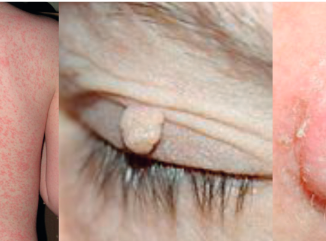Clinical oncologists face many challenges to identify the best use of the anti-EGFR drugs in patients with non-small-cell-lung cancer. Thanks to genetic analysis, they are now able to identify responders from non-responders and to counteract the development of resistance. How to cover the cost of the treatment for all the patients who could benefit remains an issue
The cool wind that cleared the sky and refreshed the heat of the previous day could not prevent the temperature rising at the ESMO 2017 Congress in Madrid, last September, when breaking results from the FLAURA trial were presented. The study was designed to test the third-generation EGFR-TKI inhibitor osimertinib, till then used against EGFR T790M resistance mutations, as first-line treatment in patients with EGFR mutation–positive advanced non–small-cell lung cancer (NSCLC).
The oncologists from all over Europe who were crowding the room were stunned by the data presented by Suresh Ramalingam, Deputy Director of the Winship Cancer Institute of Emory University in Atlanta, Georgia, and principal investigator on the trial. When he stepped up to the podium, he showed results that on a dime changed again the approach to non-small-cell-lung cancer (NSCLC) treatment, for which the guidelines had been updated just few weeks before by both ASCO in USA and ESMO in Europe (Postmus K et al, 2017; Hanna N et al, 2017).
The double revolution is going on refining treatment strategies for mainly non-smoking patients with EGFR-mutant NSCLC, whose prognoses, thanks to precision medicine, have already changed considerably over the past 15 years, more than doubling median overall survival, a story that has had many twists and turns.
The first targeted therapy ever approved for lung cancer, gefitinib, received a green light from the US Food and Drug Administration (FDA) for use in patients with advanced NSCLC in 2003. Its first performances, though, were quite disappointing: only two years later, the Agency withdrew its approval, because of the low rate of response recorded in the real world.
In the meantime, however, researchers were creating the premises for a change. In 2005, three different US groups simultaneously arrived at the same answer to a question that had been puzzling oncologists (Paez JA et al, 2004; Lynch TJ et al, 2004; Pao W et al, 2004): why, despite the average low rate of success that led to the FDA withdrawing approval, was the drug was so active in some patients, and not in others?
Created equally but not for EGFR
The solution lay in the different responses among different ethnic groups, and in particular in the fact that a higher proportion of patients were responsive to treatment among East Asian populations than Caucasians. Based on that observation, researchers showed that mutations in exons 19 and 21 of the EGFR gene, which are much more common patients of Asian ethnicity, boosted the drug activity not only of gefitinib, but also the other EGFR inhibitors available at that time, such as erlotinib and, much more recently, afatinib.
 While about 10‑15% of NSCLCs are EGFR-mutant in Caucasians, the proportion approaches 40% in East Asians, and according to some reports exceeds 50% in Chinese patients with lung adenocarcinoma (Shi YK et al, 2015). This means a huge potential market for pharmaceutical companies, which were therefore eager to fund trials in order to show the efficacy of these drugs in these specific subgroups of patients.
While about 10‑15% of NSCLCs are EGFR-mutant in Caucasians, the proportion approaches 40% in East Asians, and according to some reports exceeds 50% in Chinese patients with lung adenocarcinoma (Shi YK et al, 2015). This means a huge potential market for pharmaceutical companies, which were therefore eager to fund trials in order to show the efficacy of these drugs in these specific subgroups of patients.
“Results from those trials were so satisfying that, within a couple of years there was a consensus in the oncology community that all NSCLC patients should receive genetic testing for EGFR mutations” remembers Marina Chiara Garassino, head of the Thoracic and Lung Oncology Department at the Istituto Nazionale Tumori in Milan, Italy. “Even if such mutations are much more common in non-smokers, they can sometimes be found also in smoking patients, who could also benefit from the targeted therapy. That’s why it should be offered to everyone”.
The aim of comprehensive testing was not easy to implement globally, though, and, around 10 years on, we cannot say that it is routine practice everywhere. “As stated by the ESMO guidelines, very effort should be made to pursue it, as an essential tool to guarantee all patients with advanced NSCLC the best treatment” said Alberto Costa, clinical oncologist and Cancerworld editor while commenting on the future development of the clinical practice in NSCLC.
“In patients with EGFR-mutant NSCLC, first generation inhibitors such as gefitinib, erlotinib and afatinib provide better results than chemotherapy, prolonging progression-free survival” says Garassino. “In several studies, the survival of patients with cancer-driving genes who received targeted therapy proved to be superior to those who had driving genes but received chemotherapy” (Kris Mg et al, 2014).
EGFR inhibitors therefore earned regulatory approval as frontline therapy for patients with advanced EGFR-mutant lung cancer. But this wasn’t the end of the story.
Once again, resistance is the challenge
As usual in cancer treatment, resistance lurked. “Drug-resistance almost invariably develops after about 12 months from the beginning of the treatment with first-generation EGFR inhibitors” the Italian oncologist continues. “So, at that time, patients unfortunately had to come off their single-pill targeted therapy quite quickly, and start on chemotherapy.”
But researchers didn’t give up. In 2010, a secondary mutation on exon 20, called T790M, was discovered to be responsible for resistance to EGFR inhibitors in about six out of ten patients (Pao W et al, 2005).
As soon as the new target was identified, the race to develop a new bullet started. AstraZeneca, the same company that had developed gefitinib, won, producing the first drug aimed at blocking this resistance, osimertinib. In phase I and II studies, when cause of the resistance was T790M, the new oral drug showed more than 60% response. Such results prompted the FDA to approve it, in 2015, for treating patients with EGFR T790M mutation-positive NSCLC that was progressing after treatment with EGFR inhibitors, with approval from the European Medicine Agency (EMA), following in early 2016 (Janne PA et al, 2015). Under pressure from patients and doctors, who wanted access to the drug outside of clinical trials as soon as possible, this took place even before the phase III study, AURA3, was performed.
“When we analysed data from AURA3 trial on 419 patients, we were able to confirm that early approval for second-line use had been justified” claims Garassino, who participated in the study. “After the development of resistance, the median duration of progression-free survival was significantly longer with osimertinib than with platinum therapy plus pemetrexed [10.1 vs 4.4 months], and the objective response rate was also significantly better” (Mok TS et al, 2017).
Right to the brain
The new molecule showed other merits. “Notable were the data regarding central nervous system spread (CNS), which I myself had the joy of presenting at the ASCO meeting 2017 in Chicago” Garassino continues. “Among patients with metastases to the central nervous system, the median duration of progression-free survival was doubled in those receiving the new drug, compared with those who received chemotherapy. The new treatment made their prognosis similar to that of patients without CNS involvement.”
Brain metastases are common in patients with NSCLC, where they come with a significant burden of symptoms and impairment of the patient’s quality of life. Despite treatment with early-generation EGFR inhibitors, up to 40% of patients who progress during or after treatment develop brain and/or leptomeningeal metastases, which are difficult to treat because of the difficulty of getting drugs to penetrate through the blood–brain barrier (Santarpia N et al, 2017).

“The CNS activity with osimertinib in EGFR-mutation–positive NSCLC mimics that of the ALK inhibitor alectinib in ALK-positive NSCLC. We are going to hit a point where with drugs like alectinib, which has a very similar profile in ALK, and osimertinib, you’re not going to need that radiation oncology consult if you find brain metastases on your staging MRI” Edward Kim, chair of Solid Tumor Oncology and Investigational Therapeutics at the Levine Cancer Institute, by Carolinas HealthCare System, at Charlotte, North Carolina, declared to Cure “I would even argue that, if you tested for the biomarkers and found EGFR or ALK, and the patient was a good candidate for either of these drugs, you don’t even need the MRI right away, because you know it’s going to spread to that area. I foresee we are not going to need that down the road; it will be a little bit of a practice change, and it will take some time.”
The ability to neutralise the effect of CNS involvement in progression-free survival was very good news for doctors, health journalists and patient advocates attending the meeting in Chicago, but a further turn of events was waiting for them with the FLAURA results announced at ESMO Congress in Madrid at the end of the summer.
From resistance-rescue to first-line treatment
To test the hypothesis that early treatment with osimertinib could prevent the emergence of T790M as a mechanism of resistance and improve progression-free survival, researchers tried using the new drug as first-line therapy.
Among 556 patients with previously untreated, EGFR-mutation-positive advanced NSCLC, who were randomly assigned to receive either osimertinib or a standard EGFR-TKI (gefitinib or erlotinib), the median progression-free survival was significantly longer with osimertinib (18.9 months vs 10.2 months). While data on overall survival are still immature, they show an encouraging trend that favours osimertinib, with 83% of patients randomised to that drug still alive at 18 months compared to 71% of those randomised to treatment with standard EGFR-TKIs.
The data seem to call for a further change to the recently updated ESMO and ASCO recommendations, which had incorporated the AURA 3 results by recommending the use of osimertinib as a second-line therapy, instead of chemotherapy, for patients with sensitising EGFR mutation and progression following first-line EGFR targeted therapy, in tumours with the T790M mutation.
Is it time to rethink first-line therapy as well? “The FLAURA results position osimertinib as the preferred option for first-line therapy for EGFR-mutated NSCLC” affirms Suresh Ramalingam, who led the FLAURA study, which was published online in November in the New England Journal of Medicine (Soria JC et al, 2018). “With the publication of the results, I anticipate that it will be adopted in the treatment guidelines of various organisations. It is already recommended by the US National Comprehensive Cancer Network (NCCN) guidelines”.
So far, we’ve been discussing the use of EGFR inhibitors just to tackle metastatic disease, with research moving forward so quickly, the possibility to use it as adjuvant therapy cannot be ruled out. “The role of EGFR inhibitors in early stage disease as adjuvant therapy is still under evaluation,” says Ramalingam. “A Chinese study reported promising results with gefitinib, and the survival results of this study are eagerly awaited (Zong W et al, 2018). An ongoing US intergroup study is designed to answer this question also. We will see”.
A fork in the road
The debate now is mainly about the best sequencing of treatment. There is no strong consensus, so each situation should therefore be discussed with the patient, as their preferences, needs, and conditions of life can tip the scales towards either option.
Some oncologists believe that traditional EGFR inhibitors (gefitinib, erlotinib or afatinib) should be the preferred option up front. In this case, the development of resistance associated with the T790M mutation must be monitored, to be ready to shift to osimertinib, at least in patients who carry the mutation (about 60%). Such resistance can be detected either by tumour biopsy or with more innovative tools, such as blood tests (the so-called liquid biopsy). In this way, when resistance to the new drug develops, they will still have a bullet in reserve – chemotherapy. In patients without the T790M mutation, chemotherapy would be used as a second-line treatment.
Other oncologists think it wisest to ‘go for broke’, starting with the best up front, which is osimertinib. Its action lasts longer than previous drugs, and when resistance develops, you still have chemotherapy.
“I would suggest this option for several reasons” argues Garassino. “First of all, on account of its safety and tolerability profile”. Despite some skin rashes and diarrhoea, even ‘older’ EGFR inhibitors are well tolerated and easy to take orally, in a single pill daily. Nevertheless, osimertinib seems to be even better tolerated. “You give the patients the box with drugs and can forget him or her for months. They go back to their normal life with no problems to bother them, and for a longer time of progression-free period.”
Starting with osimertinib also avoids the need to monitor the development of resistance in patients with the T790M mutation, which requires a high-specialised, well-equipped, cancer centre, and most lung-cancer patients cannot be followed-up in one of these, but are treated in community hospitals, where genetic testing is harder to achieve.
The downside of using osimertinib up front is that, in second line, the only tool left will be chemotherapy. “But resistance to osimertinib has already been studied, and drugs aimed at it are currently under investigation. In China, a phase I trial has already started, so we can hope we will have further new opportunities to treat patients who become resistant to this drug as well, in the not too distant future”.
Sustainability: which cost one should count?
The other hot point, as usual, when discussing innovative therapies, is money. If gefitinib and erlotinib are expensive drugs, osimertinib is even more so.
When the recommendation for use of first-generation EGFR inhibitors in frontline was implemented, the combination use of these drugs and EGFR testing was considered a cost-effective strategy compared to chemotherapy such as carboplatin–paclitaxel for the treatment of NSCLC. The advantages were stronger in China and Japan, where EGFR mutations are more common, but also in Western countries this approach was deemed better (Narita Y et al, 2015; Skinner K et al, 2018).
In addition to the direct cost of the drug, there are one indirect costs to be considered, and the significant difference between a daily pill and chemotherapy, where patients have to undergo blood tests before and after the treatment, infusion has to be done in a controlled setting by trained staff, and the associated side effects can drive further health expenditures.
As far as osimertinib is concerned, evidence on cost-effectiveness is still lacking. A sponsored study aimed at informing the UK’s NICE health technology assessment considered that, in patients with EGFR-T790M mutation-positive NSCLC, and in a second-line setting, from a UK payer perspective, osimertinib is a cost-effective treatment option, compared with platinum-based doublet chemotherapy (PDC). By contrast, a Chinese study estimated that osimertinib treatment for T790M-mutated NSCLC is unlikely to be cost-effective, both in China and in the United States. Things could change, of course, if prices decrease. In this case, the cost-effectiveness might become favourable.
The jury is even further from reaching a verdict on the ‘osimertinib first’ approach.
But Ramalingam has no doubts: “Osimertinib results in better progression-free survival, it is better tolerated, and has better control of brain metastasis. I believe that these benefits will serve as primary drivers in the use of this drug”.





